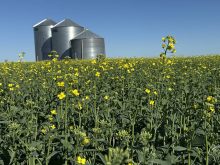U.S. test shakes market
Fed steers were $1.60 per hundredweight higher and fed heifers climbed $2.50 on average, but the market was disrupted late in the week by news of an inconclusive BSE rapid test in the U.S., said Canfax.
The report caused some Canadian plants to lower bids drastically Nov. 18 to the mid $120s, but few cattle traded at the price.
Weekly volumes rose six percent to about 23,000 head. Alberta prices Nov. 18 were steers $77.50 per cwt., $125.20-$131.35 rail and heifers $78.
Price direction this week will depend on the final BSE test results.
Read Also

Huge Black Sea flax crop to provide stiff competition
Russia and Kazakhstan harvested huge flax crops and will be providing stiff competition in China and the EU.
Alberta feedlots are current with carcass weights nearly 30 lb. lighter than a year ago.
Beef price slips
Canadian cutouts fell with AAA down $1-$3 and AA down $1-$1.25.
Cutouts are about 10 percent lower than they were a year ago, reflecting the stronger loonie.
The U.S. cutout gained $6.50-$7.50 US reflecting better business and the smaller slaughters. Calgary wholesale beef prices saw handyweight steers at $134-$140 Cdn. A smaller kill in Canada two weeks ago allowed inventories to become more current. Large Canadian plants are unlikely to run Saturday.
Feeder volume tightens
Auction market volumes fell with Alberta markets trading about 61,000 head, down 18 percent. The smaller volume helped push up price averages, with all weight categories higher, but the price range is wide due to lighter calves and variation in the number of buyers.
Steers 300-700 lb. traded $2.25-$3.75 per cwt. stronger, while 700-900 lb. were up $1.25-$1.50. Steers 900 lb. and heavier were $2.50 higher.
Light heifer calves 300-600 lb. were up $5.25-$6.50. Heifers 600-900 lb. rose $1.50-$2 and 900 lb. and heavier traded $2.75 higher.
D1, 2 cows in Alberta were steady, averaging $20.25.
Eastern cow trade started to pick up with slaughter capacity increasing.
Feeder volumes are expected to continue tapering off toward the end of the year.
Prices this week will reflect the fate of the BSE test.
Stock bred cows in Alberta were $250-$500 on poor quality, $500-$700 on medium quality and $700-$900 on excellent quality.
Bred heifers in northern Alberta were $340-$810 and in southern Alberta $700-$1,100. Cow-calf pairs in northern Alberta on limited trade brought $420.
Cash hogs stronger
Hog prices rose $1.02 US per cwt. Nov. 15-18. Cash hog prices were 60 percent more than last year at the same time, said Manitoba Agriculture.
The average Iowa-Minnesota daily direct hog price (51-52 percent lean carcass converted to live weight) rose from $60.09 per cwt. Nov. 15 to $61.11 Nov. 18. The wholesale pork cutout was nearly steady to the previous week at $77.39 per cwt. Nearby lean hog futures varied little while deferred contract months rose as speculators bet that if the BSE test was confirmed, pork export demand would continue high.
Current carcass weight data suggests hog producers may have pulled marketings forward in September and now have slowed marketings in October and November, said the weekly report from Ron Plain and Glenn Grimes of the University of Missouri.
In Manitoba, the average slaughter (all in) price on a dressed weight basis paid for all hogs was estimated at $178 Cdn per 100 kg, compared to the previous week’s actual price of $174.63, said Manitoba Agriculture. Manitoba weanling prices rose again. The top spot prices for five kg and 23 kg weanlings were higher than the top contract prices. For the week ending Nov. 12, five kg spot prices were to a high of $55.11 per pig and 23 kg prices were to a high of $89.85 per pig.
Lamb prices fall
Ontario Stockyards reported 2,854 sheep and lambs and 556 goats traded. Light grain-fed lambs traded $10-$15 cwt. lower, while heavy lamb prices fell as much as $10 cwt. Sheep prices were barely steady. Kid goats fell $10 per head, while all other classes were barely steady.
















